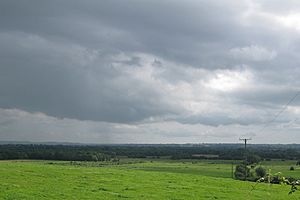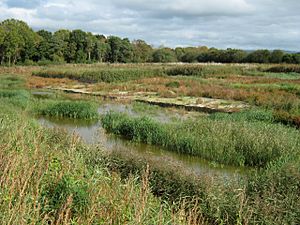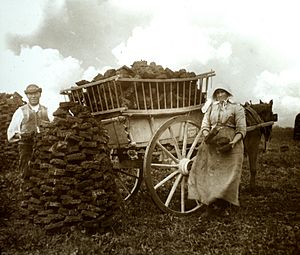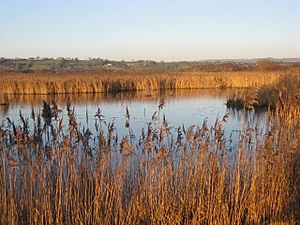Westhay Moor facts for kids
| Site of Special Scientific Interest | |

Westhay Moor area, seen from the north
|
|
| Area of Search | Somerset |
|---|---|
| Coordinates | 51°11′50″N 2°46′53″W / 51.19710°N 2.78136°W |
| Interest | Biological |
| Area | 5.137 square kilometres; 1.9833 square miles (1,269.3 acres) |
| Notification | 1971 |
Westhay Moor is a special nature area in Somerset, England. It covers about 513.7 hectares (1,269.3 acres). This area is protected because it's a Site of Special Scientific Interest, meaning it's important for its plants and animals. It's also part of a larger protected area called the Somerset Levels and Moors. This includes a Special Protection Area for birds and a Ramsar site, which is a wetland of international importance. Westhay Moor is also a National Nature Reserve.
For thousands of years, a thick layer of peat has built up in this low, wet area. Ancient people, like the Neolithics, lived nearby and used the plants from the reed beds. They even built wooden paths to cross the squishy ground. People have been digging up peat here since the Romans were around. Later, monks from Glastonbury Abbey and others worked to drain the land. This involved digging many ditches, called "rhynes," and canals. Peat digging was very popular in the 1960s but has slowed down since then.
The unique ground and the history of peat digging have created a special home for many different plants and animals. Much of the nature reserve is managed by the Somerset Wildlife Trust. They have turned old peat digging sites into flooded areas, which are now perfect for wildlife. Westhay Moor is especially famous for the millions of starlings that gather there in winter.
Contents
Where is Westhay Moor?
Westhay Moor is part of the Somerset Levels and Moors. This whole area is very flat and low. It was formed about 10,000 years ago, after the last ice age ended. As the sea level changed, lots of plants grew and died, slowly turning into peat. The most peat formed about 6,000 years ago, when the area was a big swamp.
The moor has a high water level for most of the year. This means it often floods in winter. Even where peat was dug out, the holes often fill with water. The River Brue and Galton's Canal flow through this area.
A Look Back in Time: History of Westhay Moor

Westhay Moor was once at the center of a large raised bog. This was a type of wetland that grew higher than the land around it. People from the Neolithic period (Stone Age) used the natural resources here. They built wooden paths, called trackways, to cross the wet ground.
One famous path is the Sweet Track. It was found in 1970 and is one of the oldest wooden paths in the world! It was built over 5,800 years ago. This path connected an island at Westhay to higher ground near the River Brue. Other similar paths have been found nearby. They helped people travel across the bog.
Ancient Lakes and Drainage
A large lake called Meare Pool used to cover the eastern part of the moor. It was formed by water getting trapped behind the raised peat bogs. In ancient times, there were two Meare Lake Villages built in the lake. People lived in these villages between 300 BCE and 100 CE.
Monks from Glastonbury Abbey started draining the area in the 1100s. They worked to make the lake smaller. By the 1700s, Meare Pool had completely disappeared from maps. The monks also changed the path of the River Brue to help with drainage.
Over the years, more and more drainage work was done. This included digging many "rhynes" (ditches) to control water levels. These efforts helped turn the wet moorland into farmland. Today, the water levels are managed by a system of sluice gates and pumps.
Duck Decoys
In the early 1700s, people built "duck decoys" on the moor. These were special pools with curving ditches covered in nets. They were used to catch ducks for food.
Peat Digging and Restoration
Lots of peat formed in the Somerset Levels after the ice melted. People have been digging peat here since Roman times. It was used as fuel and later for gardening. After World War II, peat digging became a big industry, especially for selling to gardeners.
However, digging peat lowered the water levels in the area. This put the local ecosystems (the living things and their environment) at risk. In 1970, the Somerset Wildlife Trust started buying parts of Westhay Moor. They wanted to protect the last remaining untouched peat bog.
Since then, the Trust has bought more land that used to be peat workings. They have worked hard to restore these areas into wetlands. This project is called the Avalon Marshes. It has been very successful, and Westhay Moor was declared a National Nature Reserve in 1995. Today, most peat digging is stopping, and the land is being returned to its natural wetland state.
Wildlife at Westhay Moor
Westhay Moor is home to many amazing creatures, especially tiny ones like invertebrates (insects, spiders, etc.). It has at least 28 nationally important invertebrate species. The meadows, ditches, and old peat workings are also perfect places for many different birds to breed.
The moor is part of a bigger project called the Brue Valley Living Landscape. This project started in 2009. Its goal is to bring back and connect different natural areas. This helps plants and animals move around and survive, especially with climate change. It also makes sure farmers can still use their land.
The Somerset Wildlife Trust manages a large part of the moor as a nature reserve. It has open water, reedbeds, and a rare piece of acid mire (a type of bog). This reserve is a fantastic place for birds. Millions of starlings gather here between November and January. You might also spot bitterns and migrating ospreys. Otters and beautiful banded demoiselle dragonflies also live on the moor. There's a large bird hide with a raised boardwalk, so visitors can watch the birds without disturbing them.




